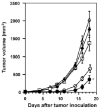Nanoparticle delivery systems in cancer vaccines
- PMID: 20721603
- PMCID: PMC3559243
- DOI: 10.1007/s11095-010-0241-4
Nanoparticle delivery systems in cancer vaccines
Abstract
Therapeutic strategies that involve the manipulation of the host's immune system are gaining momentum in cancer research. Antigen-loaded nanocarriers are capable of being actively taken up by antigen-presenting cells (APCs) and have shown promising potential in cancer immunotherapy by initiating a strong immunostimulatory cascade that results in potent antigen-specific immune responses against the cancer. Such carrier systems offer versatility in that they can simultaneously co-deliver adjuvants with the antigens to enhance APC activation and maturation. Furthermore, modifying the surface properties of these nanocarriers affords active targeting properties to APCs and/or enhanced accumulation in solid tumors. Here, we review some recent advances in these colloidal and particulate nanoscale systems designed for cancer immunotherapy and the potential for these systems to translate into clinical cancer vaccines.
Figures





References
-
- Cancer Facts & Figures 2009. American Cancer Society; Atlanta: 2009.
-
- Blattman JN, Greenberg PD. Cancer immunotherapy: A treatment for the masses. Science. 2004;305:200–205. - PubMed
-
- Diebold SS, Kaisho T, Hemmi H, Akira S, Sousa CRE. Innate antiviral responses by means of TLR7-mediated recognition of single-stranded RNA. Science. 2004;303:1529–1531. - PubMed
Publication types
MeSH terms
Substances
Grants and funding
LinkOut - more resources
Full Text Sources
Other Literature Sources
Miscellaneous

